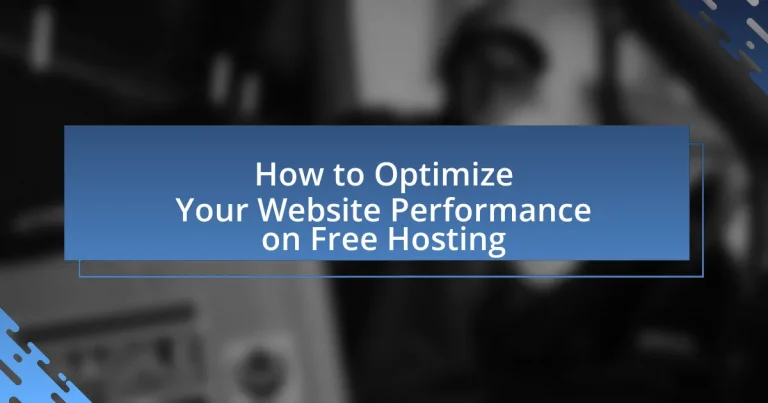Website performance optimization on free hosting is essential for enhancing speed, responsiveness, and user experience, particularly given the limitations of free hosting services such as slower server response times and bandwidth restrictions. Key optimization techniques include minimizing file sizes, leveraging browser caching, optimizing images, and utilizing content delivery networks (CDNs). The article explores the impact of website performance on user experience and search engine rankings, highlights common challenges faced with free hosting, and provides strategies for effective optimization. Additionally, it discusses the importance of monitoring performance metrics and maintaining website efficiency to ensure a positive user experience.

What is Website Performance Optimization on Free Hosting?
Website performance optimization on free hosting refers to the process of enhancing the speed, responsiveness, and overall user experience of a website hosted on a free platform. This optimization is crucial because free hosting services often come with limitations such as slower server response times, bandwidth restrictions, and less reliable uptime. Techniques for optimization include minimizing file sizes, leveraging browser caching, optimizing images, and utilizing content delivery networks (CDNs) to improve load times. Studies show that a one-second delay in page load time can lead to a 7% reduction in conversions, highlighting the importance of performance optimization even on free hosting platforms.
How does website performance impact user experience?
Website performance significantly impacts user experience by influencing loading times, interactivity, and overall satisfaction. Faster loading times lead to lower bounce rates; for instance, a study by Google found that a one-second delay in mobile load times can reduce conversions by up to 20%. Additionally, improved performance enhances user engagement, as users are more likely to interact with a site that responds quickly. Research from Akamai indicates that 47% of consumers expect a web page to load in two seconds or less, highlighting the critical relationship between performance and user retention. Thus, optimizing website performance is essential for maintaining a positive user experience.
What factors contribute to website loading speed?
Website loading speed is primarily influenced by factors such as server response time, file sizes, image optimization, and the use of caching. Server response time affects how quickly a server can process requests; for instance, a study by Google indicates that a one-second delay in loading time can reduce conversions by 7%. File sizes, including HTML, CSS, and JavaScript, directly impact loading speed; minimizing these files can significantly enhance performance. Image optimization, which involves compressing images without losing quality, is crucial as unoptimized images can account for up to 60% of a webpage’s total weight. Lastly, caching mechanisms store frequently accessed data, allowing for faster retrieval and improved loading times, as evidenced by research from the HTTP Archive showing that sites utilizing caching can load up to 50% faster.
How does performance affect search engine rankings?
Performance directly affects search engine rankings by influencing user experience and engagement metrics. Search engines like Google prioritize fast-loading websites because they enhance user satisfaction; studies show that a one-second delay in page load time can lead to a 7% reduction in conversions. Additionally, performance metrics such as page speed, mobile responsiveness, and server response time are critical factors in search algorithms. For instance, Google’s Core Web Vitals, which include loading performance, interactivity, and visual stability, are explicitly used to assess site quality and rank pages accordingly. Therefore, optimizing website performance is essential for improving search engine visibility and attracting more organic traffic.
Why is optimizing performance crucial for free hosting?
Optimizing performance is crucial for free hosting because it directly impacts user experience and website functionality. Free hosting services often have limited resources, which can lead to slower load times and reduced reliability. According to a study by Google, 53% of mobile users abandon sites that take longer than three seconds to load, highlighting the importance of speed in retaining visitors. Additionally, optimized performance can enhance search engine rankings, as search engines prioritize fast-loading websites. Therefore, effective performance optimization is essential for maximizing the benefits of free hosting while mitigating its inherent limitations.
What limitations do free hosting services impose?
Free hosting services impose several limitations, including restricted bandwidth, limited storage space, and lack of customer support. These constraints can hinder website performance, as restricted bandwidth may lead to slower loading times during high traffic, while limited storage can prevent the hosting of larger files or databases. Additionally, the absence of customer support can complicate troubleshooting and maintenance, impacting overall user experience.
How can optimization mitigate these limitations?
Optimization can mitigate limitations in website performance on free hosting by enhancing resource allocation and improving loading speeds. By implementing techniques such as image compression, caching, and minimizing HTTP requests, websites can operate more efficiently within the constraints of limited server resources. For instance, studies show that optimizing images can reduce their size by up to 80%, significantly decreasing load times and bandwidth usage. Additionally, utilizing content delivery networks (CDNs) can distribute content more effectively, further alleviating the strain on free hosting servers. These strategies collectively lead to a more responsive user experience, even when hosting capabilities are restricted.
What are the common challenges faced with free hosting?
Common challenges faced with free hosting include limited storage and bandwidth, lack of customer support, and potential security vulnerabilities. Free hosting services often impose strict limits on the amount of data and traffic a website can handle, which can lead to slow loading times and downtime. Additionally, these services typically do not offer reliable customer support, making it difficult for users to resolve issues quickly. Security is also a concern, as free hosting providers may not implement robust security measures, leaving websites vulnerable to attacks.
How does bandwidth affect website performance?
Bandwidth directly affects website performance by determining the amount of data that can be transmitted between the server and users in a given time frame. Higher bandwidth allows for faster loading times and smoother user experiences, as more data can be sent simultaneously. Conversely, limited bandwidth can lead to slower page loads, increased latency, and potential downtime during peak traffic periods. For instance, a website with a bandwidth limit of 1 Mbps may struggle to serve multiple users at once, resulting in delays, while a site with 10 Mbps can handle more simultaneous visitors efficiently. This relationship is crucial for optimizing website performance, especially on free hosting platforms where bandwidth may be restricted.
What role does server location play in loading times?
Server location significantly impacts loading times by determining the physical distance between the server and the user. When a server is closer to the user, data travels a shorter distance, resulting in faster loading times. For instance, studies show that reducing the distance by just 100 miles can decrease loading times by approximately 1 millisecond. This latency reduction is crucial for user experience, as faster loading times lead to lower bounce rates and higher engagement. Therefore, selecting a server location that is geographically closer to the target audience is essential for optimizing website performance.
How can you effectively optimize your website on free hosting?
To effectively optimize your website on free hosting, focus on minimizing resource usage and enhancing loading speed. Utilize lightweight themes and optimize images to reduce file sizes, which can significantly improve performance. Implement caching techniques, such as browser caching and using a Content Delivery Network (CDN), to decrease load times. Additionally, limit the use of heavy plugins and scripts, as they can slow down your site. According to Google, a loading time of under three seconds is crucial for retaining visitors, making these optimizations essential for user experience and search engine ranking.
What tools can help analyze website performance?
Google PageSpeed Insights is a tool that can help analyze website performance by providing insights into loading speed and optimization opportunities. This tool evaluates a webpage’s performance on both mobile and desktop devices, offering a score along with specific recommendations for improvement, such as image optimization and script minification. Additionally, GTmetrix is another effective tool that combines Google Lighthouse and WebPageTest to analyze page speed and provide detailed reports on various performance metrics, including time to first byte and fully loaded time. These tools are widely used in the industry, with Google PageSpeed Insights being referenced in numerous web performance optimization studies, highlighting their reliability and effectiveness in improving website performance.
How can image optimization improve loading speed?
Image optimization improves loading speed by reducing the file size of images without significantly compromising quality. Smaller image files require less bandwidth and load faster, which enhances user experience and can positively impact search engine rankings. For instance, studies show that optimized images can reduce page load times by up to 80%, leading to lower bounce rates and higher engagement. Additionally, tools like JPEGmini and TinyPNG demonstrate that effective compression techniques can maintain visual fidelity while achieving substantial size reductions, further validating the importance of image optimization in web performance.
What strategies can enhance website performance on free hosting?
To enhance website performance on free hosting, optimizing images is crucial. Compressed images reduce load times significantly, as studies show that images can account for up to 70% of a webpage’s total size. Additionally, utilizing a Content Delivery Network (CDN) can improve loading speeds by distributing content across multiple servers, thus reducing latency. Implementing caching strategies, such as browser caching, allows frequently accessed resources to be stored locally, which decreases server requests and speeds up page loading. Furthermore, minimizing HTTP requests by combining CSS and JavaScript files can streamline the loading process, as each request adds to the overall load time. These strategies collectively contribute to a more efficient and faster website experience, even on free hosting platforms.
How does caching improve website speed?
Caching improves website speed by storing frequently accessed data temporarily, allowing for quicker retrieval on subsequent requests. When a user visits a website, caching saves elements like HTML pages, images, and scripts, reducing the need to fetch this data from the server each time. This significantly decreases load times, as accessing cached data is faster than retrieving it from the original source. Studies show that effective caching can reduce page load times by up to 50%, enhancing user experience and engagement.
What are the best practices for minimizing HTTP requests?
To minimize HTTP requests, combine multiple CSS and JavaScript files into single files. This practice reduces the number of requests made by the browser, as each file requires a separate HTTP request. For instance, using tools like Webpack or Gulp can automate the process of file concatenation. Additionally, implement image sprites to combine multiple images into one, which decreases the number of image requests. According to Google, reducing the number of HTTP requests can significantly improve page load times, enhancing overall website performance.
What are the potential pitfalls of free hosting optimization?
The potential pitfalls of free hosting optimization include limited resources, lack of support, and security vulnerabilities. Free hosting services often impose restrictions on bandwidth and storage, which can lead to slow website performance and downtime during traffic spikes. Additionally, these services typically offer minimal customer support, making it difficult to resolve issues quickly. Security is another concern, as free hosting providers may not implement robust security measures, leaving websites vulnerable to attacks and data breaches. These factors can significantly hinder the effectiveness of website optimization efforts.
How can you avoid common mistakes in performance optimization?
To avoid common mistakes in performance optimization, prioritize identifying and addressing bottlenecks in your website’s loading speed. Conduct thorough performance audits using tools like Google PageSpeed Insights or GTmetrix to pinpoint areas needing improvement. For instance, optimizing images and leveraging browser caching can significantly enhance load times, as studies show that a one-second delay in page response can lead to a 7% reduction in conversions. Additionally, avoid excessive use of plugins, as they can slow down your site; research indicates that websites with fewer than 20 plugins load 50% faster than those with more. Regularly monitor performance metrics and adjust strategies based on data-driven insights to ensure continuous optimization.
What should you monitor to ensure ongoing performance?
To ensure ongoing performance of a website on free hosting, you should monitor key metrics such as website uptime, page load speed, and server response time. Monitoring uptime ensures that the website is accessible to users, with a target of 99.9% uptime being ideal for optimal user experience. Page load speed is crucial, as studies show that a delay of just one second can lead to a 7% reduction in conversions. Additionally, tracking server response time helps identify potential bottlenecks in performance, with a recommended response time of under 200 milliseconds for optimal user engagement. Regularly analyzing these metrics allows for timely adjustments and improvements, ensuring the website remains efficient and user-friendly.
What are the best tips for maintaining website performance on free hosting?
To maintain website performance on free hosting, optimize images and minimize file sizes. Large images can significantly slow down loading times, so using formats like JPEG or WebP and compressing files can enhance speed. Additionally, leverage browser caching to store frequently accessed resources, reducing load times for returning visitors. Implementing a Content Delivery Network (CDN) can also improve performance by distributing content across multiple servers, decreasing latency. Regularly monitor website speed using tools like Google PageSpeed Insights to identify and address performance issues promptly. These strategies are effective as they directly target common performance bottlenecks associated with free hosting environments.


